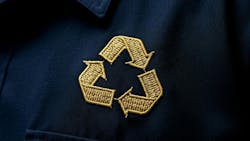From Waste to Worth: How Law Enforcement Can Lead on Uniform Recycling
What to Know
- Textile waste from uniforms contributes heavily to landfills and greenhouse gas emissions, with law enforcement uniforms being a prime target for recycling efforts.
- Police uniforms are ideal for recycling due to their standardized fabrics and existing collection points, making the process more efficient and impactful.
- Implementing uniform recycling programs can enhance community trust, demonstrate environmental responsibility, and reduce the department’s carbon footprint.
More on OFFICER.com
Download the September/October issue of OFFICER Magazine.
Click Here to subscribe to OFFICER Magazine.
Police officers and public safety professionals don’t usually think of themselves as fashion icons. Let’s be honest: the point of a uniform isn’t to grace a runway, it’s to command authority, provide protection and identify you as the one person in the room who can actually do something about the chaos. But whether you’re a patrol officer, a corrections professional or a dispatcher, your uniform is still part of a massive global textile system — and that system has a serious waste problem.
A new report from Boston Consulting Group, Spinning Textile Waste into Value, lays it out in numbers that should make anyone sit up straighter in their duty chair. In 2024, the world produced 120 million metric tons of textile waste. Picture more than 200 Olympic stadiums filled to the brim with discarded clothes, boots, and gear. By 2030, that could climb past 150 million metric tons a year if nothing changes.
The kicker? About 80 percent of that waste went to landfills or incinerators. Less than one percent made its way back into new fibers. And in the process, the planet lost about $150 billion in raw material value — every single year. That’s not just a fashion problem. That’s a budget problem, a supply chain problem, and yes, an environmental problem.
Now, you might be thinking: “Look, Levine, I already have enough to worry about with staffing shortages, paperwork, and remembering which day the duty schedule rotates. Textile waste isn’t exactly top of my list.” Fair enough. But uniforms are a huge slice of this issue — and law enforcement agencies are in a unique position to help turn the tide.
Why uniform recycling matters for law enforcement
Law enforcement uniforms are designed to last. They’re tougher, more standardized, and produced in larger volumes than most consumer apparel. That’s good news for recycling, because it makes them easier to collect, sort, and reprocess. Unlike the fast-fashion world, where every T-shirt is different, police uniforms come in standard fabrics and colors, often purchased in bulk from trusted suppliers.
Departments also have something most clothing brands would kill for: built-in collection points. Every officer gets gear issued, and at some point, that gear gets turned back in, replaced, or rotated out. That’s the perfect setup for recycling programs. Instead of throwing old uniforms in the trash — or worse, letting them collect dust in the back of a closet — you can funnel them into structured take-back systems.
This isn’t just about being green. It’s about reputation and responsibility. Communities expect public agencies to lead by example. A police department that implements a recycling program isn’t just saving landfill space — it’s showing citizens that it takes sustainability seriously. That kind of credibility matters.
The environmental footprint you didn’t know you had
Here’s where the numbers get a little wild. Incinerating one metric ton of textiles produces the same greenhouse gas emissions as six round-trip flights between London and New York. Landfilling that same ton of material produces emissions equivalent to eight flights, plus a steady leak of microplastics. And since textiles account for more than 90 percent of the fashion industry’s total greenhouse gas emissions, keeping uniforms out of the waste stream is one of the most direct ways law enforcement agencies can shrink their environmental footprint.
Think about it this way: every time you recycle a batch of old patrol shirts or turnout gear, you’re offsetting a handful of international flights you never had to take. No jet lag, no airport security lines — just less carbon in the atmosphere.
How officers and agencies can make it happen
So what can you actually do? For individual officers, the first step is simple: don’t toss old uniforms in the household trash. If your department offers a collection or recycling program, use it. If they don’t, speak up. Just as you’d raise a hand about outdated equipment or training, you can flag sustainability as an area where your agency could lead.
Departments can take bigger steps. Start by working with your uniform suppliers and distributors. Many are already exploring take-back programs and textile-to-textile recycling partnerships. These are the folks who know the material specs inside and out, and they’re motivated to find sustainable solutions. By partnering, agencies can create collection points, set up return systems, and ensure that old uniforms get sorted and processed properly.
Agencies can also negotiate recycling options into their uniform contracts. Just as you specify durability standards or delivery timelines, you can require end-of-life solutions. Think of it as extending accountability from the first wear to the final disposal. And if your agency isn’t ready for full-blown recycling, start small. Run a pilot program with one unit. Collect turnout gear from a single division. Partner with a local recycler or textile processor to test the waters. The goal isn’t to change everything overnight, it’s to build momentum.
Where humor meets hard reality
Let’s be honest — uniform recycling doesn’t have the same adrenaline rush as a vehicle pursuit. Nobody’s going to write a TV script about the brave detective who cracked the case of the missing polyester. But sometimes leadership looks like tackling the unglamorous problems that quietly cost us money, credibility, and longterm stability.
There’s also a certain poetic justice in the idea. That uniform you wore during a midnight shift, through rainstorms, protests, or paperwork marathons — one day it gets shredded, reprocessed, and spun back into the next generation of gear. Call it reincarnation, police edition.
Working with industry partners
This is where uniform manufacturers and distributors come in. They’re already tracking the BCG report, watching regulatory changes, and responding to client demand for recycled fibers. For law enforcement, this is an invitation: involve your suppliers in the conversation. Ask them what recycled options they can provide today. Push them to help design take-back systems for tomorrow.
Manufacturers want steady, predictable streams of material for recycling. Departments can provide that. Distributors want to demonstrate value beyond just shipping boxes of shirts. Recycling partnerships let them do exactly that. It’s a win-win: you get a sustainability story to share with your community, and they build stronger, longer-term relationships with their clients.
Final thoughts
Textile waste may seem far removed from the day-to-day concerns of law enforcement. But uniforms are right at the center of this global challenge — and right at the center of the solution. By participating in recycling programs, supporting take-back initiatives, and working closely with manufacturing and distribution partners, officers and agencies can help turn waste into value.
It won’t solve every problem facing public safety, but it’s one area where small changes can add up to big results. And who knows? The next time someone asks about your uniform, you might not just tell them where you got it — you might tell them where it’s going next.
About the Author
Rick Levine
Executive Director at NAUMD
Rick Levine is the Executive Director of the NAUMD, a network of uniform, image apparel, and workwear companies created to improve supply chains, innovation, and awareness. Email him at [email protected]

